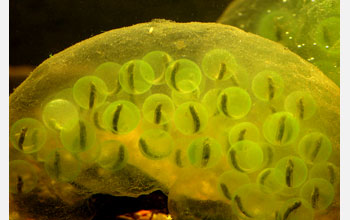Multimedia Gallery
Spotted Salamander Eggs With Developing Larvae
These spotted salamander eggs with developing larvae are green from the presence of symbiotic algae. The algae provide oxygen that helps the salamander embryos develop and the embryos provide nutrients that facilitate growth of the algae.
Symbioses is a close and often long-term relationship in which two organisms of different species share space that may or may not benefit each one.
In a study by a team of international researchers, a species of algae known to associate with spotted salamanders was discovered living inside the cells of developing embryos--the first known example of a eukaryotic algae living stably inside the cells of a vertebrate.
"It raises the possibility that more animal/algae symbioses exist that we are not aware of," said Roger Hangarter, a biologist at Indiana University (IU) Bloomington and the only American researcher on the team. "Since other salamanders and some frog species have similar algae/egg symbioses, it is possible that some of those will also have the type of endosymbioses we have seen in the spotted salamander."
To learn more about this disocovery, see the IU news story Algae that live inside the cells of salamanders are the first known vertebrate endosymbionts. (Date of Image: March 2007) [See related image Here.]
Credit: Roger Hangarter, Indiana University Department of Biology
Images and other media in the National Science Foundation Multimedia Gallery are available for use in print and electronic material by NSF employees, members of the media, university staff, teachers and the general public. All media in the gallery are intended for personal, educational and nonprofit/non-commercial use only.
Images credited to the National Science Foundation, a federal agency, are in the public domain. The images were created by employees of the United States Government as part of their official duties or prepared by contractors as "works for hire" for NSF. You may freely use NSF-credited images and, at your discretion, credit NSF with a "Courtesy: National Science Foundation" notation.
Additional information about general usage can be found in Conditions.
Also Available:
Download the high-resolution JPG version of the image. (508 KB)
Use your mouse to right-click (Mac users may need to Ctrl-click) the link above and choose the option that will save the file or target to your computer.

